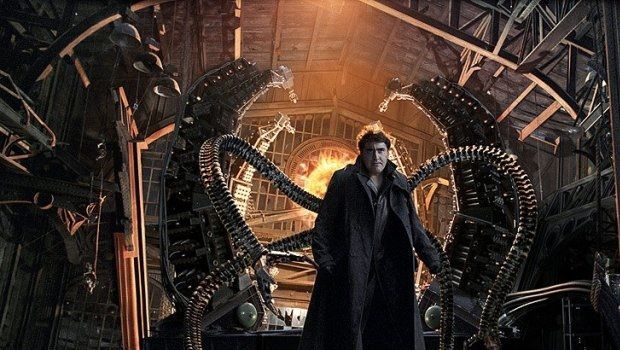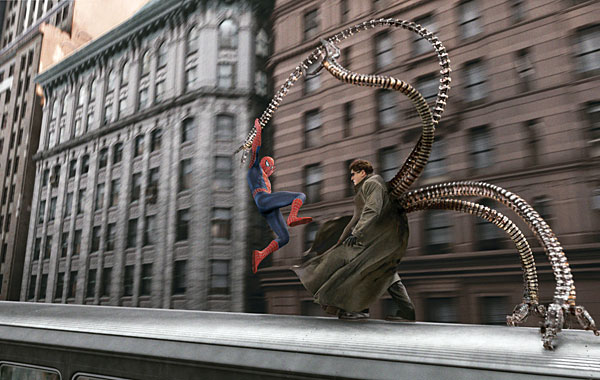
‘Spider-Man 2’ (2004) and the Save the Train Moment
Spider-Man faces off against his newest nemesis, a brilliant scientist turned villain with terrifying powers, all while the girl of his dreams moves on without him.
Peter Parker (Tobey Maguire) is still adjusting to his double life as student and crime-fighter with a secret identity. Because of his constant need to help as Spider-Man, he loses his job and further strains his already estranged relationship with Mary Jane Watson (Kirsten Dunst). Meanwhile, his friend Harry Osborne (James Franco), the head of Oscorp’s research division, introduces Peter to Otto Octavius (Alfred Molina), a brilliant nuclear scientist who has invented a new fusion power device. On the day of the project’s unveiling, Peter is invited to watch as Octavius dons a mechanical harness with four robotic arms that have artificial intelligence. When a power spike damages the reactor, it causes an explosion that kills the scientist’s wife but also incapacitates the harness’s inhibitor, causing Octavius to become hostile and run off in madness.

Directed by Sam Raimi, this follow-up to the first in the series is a huge step forward in elevating both the Peter Parker and Spider-Man characters, crafting a compelling story with some truly great visual effects. Grounding the characters with a more involving story, Spider-Man 2 finds just the right balance between plot and action, raising the right questions and offering the right answers. The sense of movement and the thrill of swinging through New York City is exhilarating, capturing the freedom and awe of what it must be like to be the superhero. But it is the conflicts, both large-scale and personal that truly drive the experience, making this one of the most critically-acclaimed and celebrated films in the genre.
The Save the Train Moment
From the first moment when Octavius transforms into Doctor Octopus (Doc Ock), Spider-Man has been there, trying to stop the once great scientist from further destruction. The relationship between these two men is given more weight as the two were friends prior to the incident (something Parker has in common with several enemies). There is a hesitancy to Spider-Man as he knows the true man behind the villainy and wants to rescue him. But there is much happening in Peter Parker’s life that leads him to abandon his alter-ego, and for a time, the city of New York is without its hero.

When he dons the costume again, he heads straight for Doc Ock, who wants nothing more than to destroy his nemesis, though it’s proving hard to do. As their battles escalate among the tops of skyscrapers, they end up falling atop a speeding rapid transit R Train heading through city. After a long skirmish that sees the two clamoring about the cars, causing windows to smash and metal to bend, Doc Ock realizes he’s outmatched and instead of trying to defeat Spider-Man, rips out the engine’s control stick after putting the train at full speed. He then escapes, leaving Spider-Man the choice of following him or saving the passengers. During this, a sharp spray of electric sparks incinerates Spider-Man’s mask, causing him to tear it off, exposing his identity. Spider-Man naturally stays with the elevated train and leaps up to the front car where he first tries to stop it with his feet, plowing through the planks on the track with no effect. When that fails, and the conductor snidely asks if he has any more ideas, Spider-Man starts using his web-slingers to act as brakes, using them to latch onto buildings like a net. He holds onto the ends with all his might, desperately attempting to reduce the speed before they approach the end of the line and fall into the Upper Bay.
With great effort, his plan works, slowing the train enough so that it screeches to a halt just as it breaks through the barrier on the end of the raised track. Exhausted by the ordeal, he collapses, but before he can fall, the passengers–through the broken front windows of the engine car–reach out and hold him in place, pulling him into safety. When he wakes, he is surrounded by relieved and grateful commuters, who, touched by the superhero’s efforts, give him his mask and pledge to keep his identity secret.

Why it Matters
We don’t often think of superheroes as sacrificing themselves for the greater good, even though that is probably a word that totally defines their lives. The thing about Peter Parker is he is young and inexperienced, a boy thrust into his role as hero by an accident. We’ve followed the transformation from the first film and we see the toll it has taken on his social and family life. Yet he never gives up this pressing need to fulfill a destiny he himself created.
Doc Ock represents the greatest threat to the city Spider-Man has faced yet, a monstrous villain with plans for destruction that must be stopped. When lives are in immediate danger, Spider-Man acts selflessly to protect them, his battle with Doctor Octopus one that is entirely crafted around suppressing the man from harming others. At great cost, Spider-Man commits himself to the battle, even when he is hit, full force, by an oncoming train that rips him from the fight. He leaps back into the fray, undaunted, diving straight at Doc Ock in a fierce display of courage and determination.

The classic moral dilemma of being forced to choose one path over another has long been a staple of the superhero genre, with many employing the trope as means to create drama. Often the hero must choose between saving one or saving many, a friend or partner or even a lover. In fact, in the first film, the Green Goblin (Willem DeFoe) forced Spider-Man to choose between Mary Jane Watson or a gondola full of children. It is framed and scripted to be traumatizing as possible, and we are meant to wonder how the hero can save everyone. Here, the choice is relatively easy of course, but it helps to firm the moral compass of Spider-Man and further establish his commitment to the people. We aren’t thinking he will abandon the train and continue after Ock, we know he will do the opposite, but it still inspires us.
The most important aspect of this moment, and reason why it remains so effective is the unmasking of the hero, a narrative decision that changes the impact of the scene entirely. Most superheroes have their faces, or at least the lower part, unobscured, which allows the audience see expressions and therefore make decisions about their actions. Spider-Man, trying to fully protect his identity, is fully masked. Nothing of his face can be seen. We rely on his constant spoken stream of consciousness or interaction with villains to know his thoughts. It’s a trademark of the character both in comic books and film. His playful commentary and humorous sidebars give us all the information we need about what he is thinking and how we should feel without seeing his face. Having the mask off changes all that, and admittedly, it’s initially awkward to see the suit with Peter Parker’s face, even though we know it’s always him under the mask. Two things happen: 1) Spider-Man is suddenly humanized, and 2) Spider-Man feels vulnerable. And that is where the genius of removing the mask comes into play. By reminding us who that it’s just a man under the mask, the effort he makes to save the train suddenly has that much more weight.

And about that train. The runaway is one of Spider-Man’s first, biggest challenges, at least with the number of people involved and the potential for disaster. Sure, the gondola could have been bad, but not to this scale. It’s also the first time we get to see him truly face what seems like an impossible situation. Of course we know he’ll succeed, but it’s the how that makes it special. The Christ-like imagery and the immense agony he endures, fully expressed on his exposed face, heighten our investment. Here is a hero with limits, something we’re not expecting. And this is his sacrificial moment, a wholly selfless act that reveals he will do whatever it takes to protect the people he’s sworn himself to protect.

When it’s over, after he’s stopped the cars and saved the commuters, what marks this moment as the best in the film, is what happens next. The people save him, the rescued now the rescuers, in a sensationally affecting moment. Carried above the passengers while Danny Elfman‘s emotional score echoes across the screen, he is set gently on to the floor. They marvel at how young he is and when he awakens and realizes they can see his face, they assure him they will keep his secret safe. They are more glad that Spider-Man is back.
This is a crucial moment, and one that might easily have been discarded in another director’s hands. Spider-Man is known throughout the city, and even if J. Jonah Jameson (J. K. Simmons) of the Daily Bugle wants to sell his newspaper by painting Spider-Man as a criminal, the people know otherwise. On the train, up close and personal with the unmasked Peter Parker, they themselves take the mantle of ‘superhero’ and defend his role. Even when Doc Ock returns. It’s a touching gesture that cements the relationship Spider-Man has with the people he serves, but also justifies for him the right choice in deciding to put the costume back on in the first place.
One of the greatest moments of any superhero movie, the train scene epitomizes the core value of Spider-Man, both as a hero and and as a man. This is great filmmaking.

Director:
Sam Raimi
Writers:
Stan Lee (comic book), Steve Ditko (comic book)
Stars:
Tobey Maguire, Kirsten Dunst, Alfred Molina, J. K. Simmons
